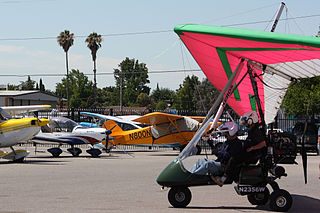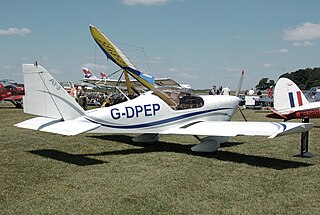
A private pilot licence (PPL) or private pilot certificate is a type of pilot licence that allows the holder to act as pilot in command of an aircraft privately. The basic licence requirements are determined by the International Civil Aviation Organization (ICAO), but implementation varies from country to country. According to ICAO, an applicant must be at least 17 years old, demonstrate appropriate knowledge and skill, and hold at least a Class 3 medical certificate. Different PPLs are available for different categories of aircraft, such as aeroplane, helicopter, airship, etc., and are not interchangeable, although experience from a PPL in one category may be credited towards the issue of another.

The European Union Aviation Safety Agency (EASA) is an agency of the European Commission with responsibility for civil aviation safety in the European Union. It carries out certification, regulation and standardisation and also performs investigation and monitoring. It collects and analyses safety data, drafts and advises on safety legislation and co-ordinates with similar organisations in other parts of the world.
Pilot licensing or certification refers to permits for operating aircraft. Flight crew licences are issued by the civil aviation authority of each country, which must establish that the holder has met minimum knowledge and experience before issuing licences. The licence, along with the required class or type rating, allows a pilot to fly aircraft registered in the licence issuing state.

A light-sport aircraft (LSA), or light sport aircraft, is a category of small, lightweight aircraft that are simple to fly. LSAs tend to be heavier and more sophisticated than ultralight aircraft, but LSA restrictions on weight and performance separates the category from established GA aircraft. There is no standard worldwide description of an LSA.

The Canadian Aviation Regulations define two types of ultralight aircraft: basic ultra-light aeroplane (BULA), and advanced ultra-light aeroplane (AULA).

The aircraft diesel engine or aero diesel is a diesel-powered aircraft engine. They were used in airships and tried in aircraft in the late 1920s and 1930s, but were never widely adopted until recently. Their main advantages are their excellent specific fuel consumption, the reduced flammability and somewhat higher density of their fuel, but these have been outweighed by a combination of inherent disadvantages compared to gasoline-fueled or turboprop engines. The ever-rising cost of avgas and doubts about its future availability have spurred a resurgence in aircraft diesel engine production in the early 2010s.

EASA CS-VLA is the European Aviation Safety Agency Certification Specification for Very Light Aircraft.

In aviation, airworthiness is the measure of an aircraft's suitability for safe flight. Initial airworthiness is demonstrated by a certificate of airworthiness issued by the civil aviation authority in the state in which the aircraft is registered, and continuing airworthiness is achieved by performing the required maintenance actions.

A type rating is an authorization entered on or associated with a pilot license and forming part thereof, stating the pilot's privileges or limitations pertaining to certain aircraft type. Such qualification requires additional training beyond the scope of the initial license and aircraft class training.

Cross-country flying is a type of distance flying which is performed in a powered aircraft on legs over a given distance and in operations between two points using navigational techniques; and an unpowered aircraft by using upcurrents to gain altitude for extended flying time. Cross country is distinct from purely aerial work in a small defined area requiring little navigation.

The Guimbal Cabri G2 is a two-seat light helicopter produced by Hélicoptères Guimbal, and powered by a reciprocating engine. Designed by Bruno Guimbal, a former Eurocopter engineer, it had its origins in the 1980s, and the first demonstrator flew in 1992. Following the granting of regulatory approval, the Cabri entered commercial service in 2008. In addition to its use within the general aviation sector and as a training rotorcraft, the Cabri G2 has also been used as the basis for unmanned aerial vehicles (UAVs).

General aviation (GA) has been defined as a civil aircraft operation other than a commercial air transport flight operating to a schedule. Although the International Civil Aviation Organization (ICAO) excludes any form of remunerated aviation from its definition, some commercial operations are often included within the scope of General Aviation (GA). General aviation refers to all flights other than military and scheduled airline flights, both private and commercial.

In aviation, a class rating is an allowance to fly a certain group of aircraft that require training common to all aircraft within the group. A type rating is specified if a particular aircraft requires additional specialized training beyond the scope of initial license and aircraft class training. Which aircraft require a type rating is decided by the local aviation authority. Almost all single-engine piston (SEP) or multi-engine piston (MEP) single pilot aircraft can be flown without a type rating, but are covered by a class rating instead.

The Pipistrel Virus is a two-seat, single engine light aircraft manufactured by Pipistrel in Slovenia and Italy and sold as an ultralight, homebuilt kit, or light-sport aircraft.

The Light Wing AC4 is a Swiss ultralight and light-sport aircraft, designed by Hans Gygax and produced by Light Wing AG of Stans. The aircraft was publicly introduced at the AERO Friedrichshafen show in 2013. It is supplied complete and ready-to-fly.
The light aircraft pilot licence (LAPL) is a pilot license allowing the pilot to fly small aircraft. It is issued in EASA member states and the United Kingdom. Unlike most other licences, it is not covered by the ICAO framework and is usually not able to be used in other states or regulatory areas.
The minimum control speed (VMC) of a multi-engine aircraft is a V-speed that specifies the calibrated airspeed below which directional or lateral control of the aircraft can no longer be maintained, after the failure of one or more engines. The VMC only applies if at least one engine is still operative, and will depend on the stage of flight. Indeed, multiple VMCs have to be calculated for landing, air travel, and ground travel, and there are more still for aircraft with four or more engines. These are all included in the aircraft flight manual of all multi-engine aircraft. When design engineers are sizing an airplane's vertical tail and flight control surfaces, they have to take into account the effect this will have on the airplane's minimum control speeds.

The Curti Zefhir is a two-seat light-single turbine-powered recreational or trainer helicopter designed and produced by Italian aircraft manufacturer Curti Aerospace. Development was partly funded by the European Commission. It performed its maiden flight in 2017 and was commercially launched at the April 2018 AERO Friedrichshafen. Curti aim to secure type certification of the Zefhir as an ultralight aircraft.

The Pipistrel Velis Electro is a Slovenian light aircraft, designed and produced by Pipistrel of Ajdovščina. The aircraft was EASA CS-LSA fully electric type certified in June 2020 and it is intended primarily for the training aircraft role, particularly multiple successive take-off and landings at the airfield. The design is the first type certified electric aircraft and is supplied complete and ready-to-fly.

EASA CS-23 is the European Union Aviation Safety Agency Certification Specification for Normal, Utility, Aerobatic and Commuter Aeroplanes.

















